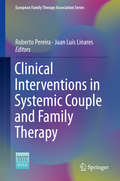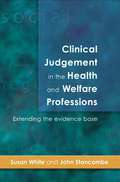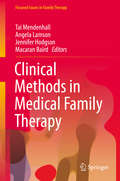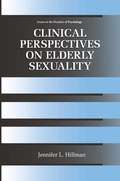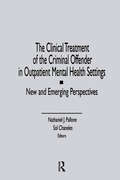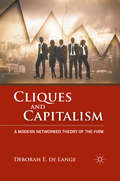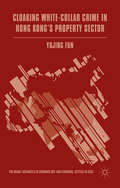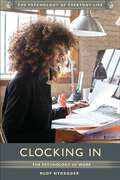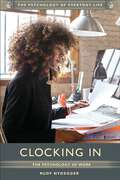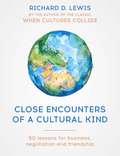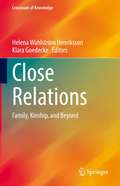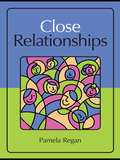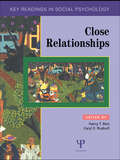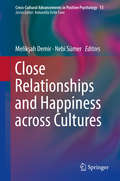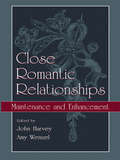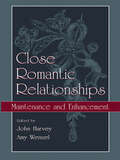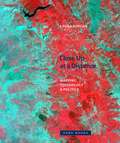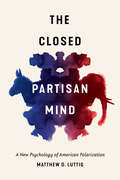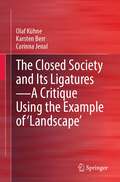- Table View
- List View
Clinical Interventions in Criminal Justice Settings: Evidence-Based Practice
by George T. Patterson Warren K. GrahamClinical Interventions in Criminal Justice Settings balances theoretical frameworks and research methodology to examine the effective evidence-based practices and principles for populations within the criminal justice system. The book explores the major clinical issues that are relevant for adopting evidence-based practices and demonstrates how to implement them. Topics include legislation, law enforcement, courts, corrections, actuarial assessment instruments, treatment fidelity, diverse populations, mental illness, substance use and juvenile delinquency. Clinical Interventions in Criminal Justice Settings models opportunities for evidence-based practice during entry into the criminal justice system (arrest), prosecution (court, pretrial release, jail, and prison), sentencing (community supervision, incarceration), and corrections (jail, prison, probation and parole). Addresses offenders in all four components of the criminal justice system—legislation, law enforcement, courts and correctionsCovers the use of actuarial risk assessment instruments for clinical decision-makingIncludes tools that predict recidivism, levels of service needed, and future offending behaviorSeparates specific practices for juvenile and adult offendersDelves into specific special populations, such as those with HIV and AIDS, substance abuse, co-occurring disorders and homelessness
Clinical Interventions in Systemic Couple and Family Therapy (European Family Therapy Association Series)
by Juan Luis Linares Roberto PereiraThis timely update presents modern directions in systemic therapy practice with couples and families, focusing on clinical innovations from Italy, Portugal, and Spain. Top therapists discuss their breakthrough family work in treating familiar pathologies such as depression, borderline personality disorder, infidelity, and addictions, providing first-hand insight into meeting relational dysfunction with creativity and resourcefulness. The book applies novel conceptualizations and fresh techniques to complex situations including multi-problem families, involuntary clients, disability-related issues, anorexia, love and sex in aging, and family grief. From tapping into the strengths of siblingship to harnessing the therapeutic potential of the Internet, the book’s cases illustrate the rich variety of opportunities to improve client outcomes through systemic couple and family therapy.This practical guide: Demonstrates strategies for therapists to improve practiceExemplifies methods for reducing the gap between clinical theory and practiceIdentifies multiple dimensions of systems thinking in case formulation and therapyOffers new insights into treating classic and recent forms of psychopathologyProvides a representative picture of couple and family therapy in southern EuropeClinical Interventions in Systemic Couple and Family Therapy is of particular relevance to practitioners and clinicians working within couple and family therapy, and is also of interest to other professionals working in psychotherapy and professional mental health services.
A Clinical Introduction to Psychosis: Foundations for Clinical Psychologists and Neuropsychologists
by Johanna C. Badcock Georgie PaulikThis practical guide outlines the latest advances in understanding and treating psychotic symptoms and disorders, articulating step-by-step the clinical skills and knowledge required to effectively treat this patient population. A Clinical Introduction to Psychosis takes an evidence-based approach that encourages a wider perspective on clinical practice, with chapters covering stigma and bias, cultural factors, the importance of social functioning, physical health, sleep, and more. A broad array of treatment modalities are discussed, including cognitive behavioral therapy, cognitive remediation, psychosocial interventions, trauma-informed therapies, and recovery-oriented practice. The book also provides a concise overview of the latest advances regarding cognitive profiles in people with psychotic disorders, the developmental progression of cognitive abilities, and the clinical relevance of cognitive dysfunction. The book additionally familiarizes readers with issues and controversies surrounding diagnostic classification, transdiagnostic expression, and dimensional assessment of symptoms in psychosis.Provides treatment and assessment methods for psychotic symptoms and disordersLooks at how psychosis develops and the impact of stigma on clinicians and clientsStudies the links between trauma, PTSD, and psychosis, as well as sleep and psychosisCovers digital technologies for treating and assessing psychosisOutlines strategies for treating visual and auditory hallucinationsExamines how to incorporate consumer and clinician perspectives in clinical practice
Clinical Judgement In The Health and Welfare Professions (UK Higher Education OUP Humanities & Social Sciences Health & Social Welfare)
by Susan White John Stancombe"I recommend this text to anyone who has an abiding interest in not how we should make decisions but how, in reality, we do."Journal of Clinical Nursing How do clinicians use formal knowledge in their practice? What other kinds of reasoning are used? What is the place of moral judgement in clinical practice?In the last decade, the problem of clinical judgement has been reduced to the simple question: what works? However, before clinicians can begin to think about what works, they must first address more fundamental questions such as: what's wrong? or what sort of problem is this? The complex ways in which professionals negotiate the process of case formulation remain radically under-explored in the existing literature. This timely book examines this neglected area. Drawing on the authors' own detailed ethnographic and discourse analytic studies and on developments in social science, the book aims to reconstitute clinical judgement and case formulation as both practical-moral and rational-technical activities. By making social scientific work more accessible and meaningful to professionals in practice, it develops the case for a more realistic approach to the many reasoning processes involved in clinical judgement. Clinical Judgement in the Health and Welfare Professions has been written for educators, managers, practitioners and advanced students in health and social care. It will also appeal to those with an interest in the analysis of institutional discourse and ethnographic research.
Clinical Methods in Medical Family Therapy (Focused Issues in Family Therapy)
by Tai Mendenhall Angela Lamson Jennifer Hodgson Macaran BairdThis landmark text describes research-informed practices and applications of Medical Family Therapy (MedFT) across a range of care environments and clinical populations (e.g., family medicine, obstetrics and gynecology, psychiatry, alcohol and drug treatment, community health centers, and military and veteran health systems). It is a timely release for a rapidly growing field. It includes the work of some of MedFT’s most innovative leaders, who expertly: illustrate MedFT in action across primary, secondary, tertiary, and other unique health contextsdescribe the make-up of healthcare teams tailored to each chapter’s distinct environment(s)highlight fundamental knowledge and critical skillsets across diverse healthcare contextsdetail research-informed practices for MedFTs who treat patients, couples, families, and communities Clinical Methods in Medical Family Therapy is a comprehensive source for any behavioral health student, trainee, or professional looking to understand the necessary skills for MedFTs entering the healthcare workforce. It is also an essential read for trainers and instructors who are covering the fundamental MedFT knowledge and skills across diverse healthcare contexts. This text was written to be applicable for a wide variety of healthcare disciplines, including family therapy, counseling nursing, medicine, psychology and social work.
Clinical Perspectives on Elderly Sexuality (Issues in the Practice of Psychology)
by Jennifer L. HillmanThroughout my clinical training and practice, I have been surprised by the number of times that sexual issues have emerged as an unexpectedly central feature in my work with older adults. I can vividly remember my own internal reaction on hearing one of my elderly female patients tell me that she was date raped a few years after the death of her elderly husband-when she was 68 years old. I can see in my mind's eye the blood splattered on the floor of an inpatient unit from an elderly man who smashed his arm through a window, furious that his antidepressant medication made it impossible to climax through masturbation. On a much less dramatic but equally important note, I think about the elderly amputee who told me softly about his fears of resuming sexual activity with his wife of 25 years. I also think about the elderly woman whose inability to take herself shopping to find fashionable, comfortable clothes to fit over her hunched shoulders and large breasts helped precipitate a serious depression. In sum, I learned early on that elderly sexuality is not just about how many times a week someone makes love. It is my hope that sharing these experiences and introducing the related theories, research, and interventions will assist other clinicians in dealing with these often challenging and clinically demanding situations. Without my patients, this text would not have been possible.
The Clinical Treatment of the Criminal Offender in Outpatient Mental Health Settings: New and Emerging Perspectives
by Letitia C PalloneThis volume brings together in a single source a set of perspectives by leaders in the clinical treatment of criminal offenders in outpatient settings, particularly those whose crimes have involved domestic violence and/or substance abuse. More than a set of “how to” techniques, it addresses the question of which offenders can successfully be treated in what settings by which techniques. It is a valuable resource not only for those concerned with prisons, probation, and parole, but also for those responsible for the delivery of mental health services in the community.
The Clinical Treatment of the Criminal Offender in Outpatient Mental Health Settings: New and Emerging Perspectives
by Letitia C PalloneThis volume brings together in a single source a set of perspectives by leaders in the clinical treatment of criminal offenders in outpatient settings, particularly those whose crimes have involved domestic violence and/or substance abuse. More than a set of “how to” techniques, it addresses the question of which offenders can successfully be treated in what settings by which techniques. It is a valuable resource not only for those concerned with prisons, probation, and parole, but also for those responsible for the delivery of mental health services in the community.
Clinician Guide to Disruptive Mood Dysregulation Disorder in Children and Adolescents
by Sam GoldsteinThis book examines disruptive mood dysregulation disorder (DMDD) during childhood and adolescence. It explores the ways in which explosive anger outbursts and persistent irritability are among the most problematic symptoms in child and adolescent mental health. and may present as a feature of many different psychiatric illnesses. The volume addresses the myriad challenges that youth with a focus on the DMDD diagnosis experience. Chapters focus on key issues of development, behavior, achievement, social relations, and mood. The book describes how to diagnose and conduct clinical assessments of child and adolescent personality and behavior with suspected DMDD. Key areas of coverage include: Comprehensive history of mood dysregulation research and current trends in psychiatric classification (e.g., DSM-5, Research Domain Criteria) and their influence on the clinical assessment of children and adolescents with suspected DMDD. Updates of professional standards to guide clinicians and diagnosticians and discussions of practical considerations in planning and conducting clinical assessments for children with DMDD. Reviews the most recent editions of questionnaires and tests used in the clinical assessment of child and adolescents with suspected DMDD. Differential diagnosis and practical methods for integrating assessment information to develop an effective, multidisciplinary treatment plan. Review of current trends in psychiatric and psychological treatment of DMDD. Clinician Guide to Disruptive Mood Dysregulation Disorder in Children and Adolescents serves as an essential resource for researchers, professors, and graduate students as well as veteran and early-career clinicians and professionals across such interrelated disciplines as school, clinical child, developmental, and educational psychology, child and adolescent psychiatry, school counseling, social work, and public health.
Cliques and Capitalism: A Modern Networked Theory of the Firm
by Deborah E. de LangeDe Lange suggests a new contextually linked building block model to develop theories of the firm in the field of strategy and organizations. Using this approach, she proposes two models: one that is a realistic American version and another that is a futuristic sustainable model. Both are new networked models that integrate current theories; a review of international corporate governance supports the sustainable firm that solves problems of the current one. Through a revised theoretical lens, the book answers a provocative question surrounding modern corporate America: Who wields the power? In this investigative look at the institutional mechanisms behind who is truly running the show, Cliques and Capitalism seeks to not only explain why the current corporate system fails to function well, but also offers solutions for improved corporate governance through a new sustainable model.
Cloaking White-Collar Crime in Hong Kong's Property Sector (Palgrave Advances in Criminology and Criminal Justice in Asia)
by Yujing FunHong Kong's anti-corruption agency, ICAC, is hailed as among the world's best having almost completely purged systemic corruption within a decade of its inception. This book explains how Hong Kong maintains the myth of a clean city and examines the prevalence of white collar crime in the city's property sector.
Clocking In: The Psychology of Work (The Psychology of Everyday Life)
by Rudy NydeggerCovering important topics such as job satisfaction, workplace stress, and the changing nature of jobs and careers in the 21st century, this valuable resource explores how working affects us psychologically, for better and for worse and sometimes in imperceptible ways.Although most people go to work Monday through Friday, few stop to think about the central role work plays in our lives. Besides allowing us to provide for the material needs of ourselves and our families, having a job or career can help us to meet new people and stay socially connected, to increase our self-esteem and sense of self-worth, and to allow us to have an impact on the world. But work can also leave us exhausted and stressed, and many people find it difficult to balance their work and personal lives.This clear and accessibly written book in Greenwood's Psychology of Everyday Life series provides readers with an understanding of the important roles work plays in our lives, the many forms work may take, and the ways in which our relationships with work change throughout our lives. The information, presented in an unassuming, easy-to-understand manner, is drawn from classical theory as well as from contemporary research, affording readers a well-rounded understanding of the topic. The book also includes a collection of real-world scenarios to illustrate key concepts as well as scholarly essays offering perspective on current issues and debates related to work in America.
Clocking In: The Psychology of Work (The Psychology of Everyday Life)
by Rudy NydeggerCovering important topics such as job satisfaction, workplace stress, and the changing nature of jobs and careers in the 21st century, this valuable resource explores how working affects us psychologically, for better and for worse and sometimes in imperceptible ways.Although most people go to work Monday through Friday, few stop to think about the central role work plays in our lives. Besides allowing us to provide for the material needs of ourselves and our families, having a job or career can help us to meet new people and stay socially connected, to increase our self-esteem and sense of self-worth, and to allow us to have an impact on the world. But work can also leave us exhausted and stressed, and many people find it difficult to balance their work and personal lives.This clear and accessibly written book in Greenwood's Psychology of Everyday Life series provides readers with an understanding of the important roles work plays in our lives, the many forms work may take, and the ways in which our relationships with work change throughout our lives. The information, presented in an unassuming, easy-to-understand manner, is drawn from classical theory as well as from contemporary research, affording readers a well-rounded understanding of the topic. The book also includes a collection of real-world scenarios to illustrate key concepts as well as scholarly essays offering perspective on current issues and debates related to work in America.
Close Encounters of a Cultural Kind: Lessons for business, negotiation and friendship
by Richard LewisRichard Lewis - world famous lecturer on intercultural issues and best-selling author of WHEN CULTURES COLLIDE - has collected 50 unique, critical cross-cultural incidents during his encounters in 135 countries around the globe. Some of these anecdotes are humorous, some are poignant, some are mysterious - all are insightful snapshots of the complex tapestry of cross-cultural business. If you're dining with a Finn, negotiating with the Japanese or attempting to climb a mountain with a team of diffident Italians, you need this book."Historically, 'cultural encounters' have often created wars and split people. In this precious little gem of a book, Richard shows how beautifully cultural barriers can be overcome when people meet face-to-face. How we, despite different outlooks, can build bridges across cultural gaps with mindful, respectful and humorous approaches. The stories, told in a vibrant and captivating voice, ranging from thought provoking and insightful to adventurous and hilarious, are a delightful read. The charming characters of broad cultural variety bring the whole world into your hands, making hearts bond over a jolly good laugh.And frankly, - what can be better?"Marit Imeland Gjesme, Founder of CultureCatch®, intercultural training consultancy
Close Relations: Family, Kinship, and Beyond (Crossroads of Knowledge)
by Helena Wahlström Henriksson Klara GoedeckeThis book speaks to the meanings and values that inhere in close relations, focusing on ‘family’ and ‘kinship’ but also looking beyond these categories. Multifaceted, diverse and subject to constant debate, close relations are ubiquitous in human lives on embodied as well as symbolic levels. Closely related to processes of power, legibility and recognition, close relations are surrounded by boundaries that both constrain and enable their practical, symbolical and legal formation. Carefully contextualising close relations in relation to different national contexts, but also in relation to gender, sexuality, race, religion and dis/ability, the volume points to the importance of and variations in how close relations are lived, understood and negotiated.Grounded in a number of academic areas and disciplines, ranging from legal studies, sociology and social work to literary studies and ethnology, this volume also highlights the value of using inter- and multidisciplinary scholarly approaches in research about close relations.Chapter 11 is available open access under a Creative Commons Attribution 4.0 International License via link.springer.com.
Close Relationships
by Pamela ReganThis multidisciplinary text introduces the concepts, methodologies, theories, and empirical findings of the field of interpersonal relationships. Information is drawn from psychology, communication, family studies, marriage and family therapy, social work, sociology, anthropology, the health sciences, and other disciplines. Numerous examples capture readers’ attention by demonstrating how the material is relevant to their lives. Active learning is encouraged throughout. Each chapter includes an outline to guide students, key terms and definitions to help identify critical concepts, and exploration exercises to promote active thinking. Many chapters include measurement instruments that students can take and score themselves. A website for instructors features a test bank with multiple-choice and essay questions and Power Points for each chapter. This text distinguishes itself with: Its focus on family and friend relationships as well as romantic relationships. Its multidisciplinary perspective highlighting the contributions to the field from a wide array of disciplines. Its review of the relationship experiences of a variety of people (of different age groups and cultures; heterosexual and homosexual) and relationship types (dating, cohabiting, marriage, friendships, family relationships). Its focus on methodology and research design with an emphasis on how to interpret empirical findings and engage in the research process. Cutting-edge research on "cyber-flirting" and online relationship formation; the biochemical basis of love; communication and social support; bullying and peer aggression; obsession and relational stalking; sexual violence (and marital rape); and grief and bereavement. The book opens by examining the fundamental principles of relationship science along with the research methods commonly used. The uniquely social nature of humans is then explored including the impact relationships have on health and well-being. Part 2 focuses on relationship development—from attraction to initiation to development and maintenance as well as the factors that guide mate choice and marriage. The development of relationships in both friendships and romantic partnerships is explored. Part 3 examines the processes that shape our interpersonal experiences, including cognitive (thinking) and affective (feeling) processes, communicative and supportive processes, and the dynamics of love and sex. The book concludes with relationship challenges—rejection and betrayal; aggression and violence; conflict and loss; and therapeutic interventions. Intended as a text for courses in interpersonal/close relationships taught in psychology, communication, sociology, anthropology, human development, family studies, marriage and family therapy, and social work, practitioners interested in the latest research on personal relationships will also appreciate this engaging overview of the field.
Close Relationships
by Pamela ReganThis multidisciplinary text introduces the concepts, methodologies, theories, and empirical findings of the field of interpersonal relationships. Information is drawn from psychology, communication, family studies, marriage and family therapy, social work, sociology, anthropology, the health sciences, and other disciplines. Numerous examples capture readers’ attention by demonstrating how the material is relevant to their lives. Active learning is encouraged throughout. Each chapter includes an outline to guide students, key terms and definitions to help identify critical concepts, and exploration exercises to promote active thinking. Many chapters include measurement instruments that students can take and score themselves. A website for instructors features a test bank with multiple-choice and essay questions and Power Points for each chapter. This text distinguishes itself with: Its focus on family and friend relationships as well as romantic relationships. Its multidisciplinary perspective highlighting the contributions to the field from a wide array of disciplines. Its review of the relationship experiences of a variety of people (of different age groups and cultures; heterosexual and homosexual) and relationship types (dating, cohabiting, marriage, friendships, family relationships). Its focus on methodology and research design with an emphasis on how to interpret empirical findings and engage in the research process. Cutting-edge research on "cyber-flirting" and online relationship formation; the biochemical basis of love; communication and social support; bullying and peer aggression; obsession and relational stalking; sexual violence (and marital rape); and grief and bereavement. The book opens by examining the fundamental principles of relationship science along with the research methods commonly used. The uniquely social nature of humans is then explored including the impact relationships have on health and well-being. Part 2 focuses on relationship development—from attraction to initiation to development and maintenance as well as the factors that guide mate choice and marriage. The development of relationships in both friendships and romantic partnerships is explored. Part 3 examines the processes that shape our interpersonal experiences, including cognitive (thinking) and affective (feeling) processes, communicative and supportive processes, and the dynamics of love and sex. The book concludes with relationship challenges—rejection and betrayal; aggression and violence; conflict and loss; and therapeutic interventions. Intended as a text for courses in interpersonal/close relationships taught in psychology, communication, sociology, anthropology, human development, family studies, marriage and family therapy, and social work, practitioners interested in the latest research on personal relationships will also appreciate this engaging overview of the field.
Close Relationships: Key Readings (Key Readings in Social Psychology)
by Harry T. ReisEach of the chapters in this reader is written by leading scholars in the area of relationships, reflecting the diversity of the field and including both contemporary and key historical papers for comprehensive coverage of research.
Close Relationships: Key Readings (Key Readings in Social Psychology)
by Harry T. Reis Caryl E. RusbultEach of the chapters in this reader is written by leading scholars in the area of relationships, reflecting the diversity of the field and including both contemporary and key historical papers for comprehensive coverage of research.
Close Relationships and Happiness across Cultures (Cross-Cultural Advancements in Positive Psychology #13)
by Melikşah Demir Nebi SümerThis volume focuses explicitly on close relationships as a reliable source for individual happiness and well-being across cultures. The work in this volume addresses theoretical issues and presents new cross-cultural data in the study of close relationships and happiness. Experts from different parts of the world provide in-depth, authoritative reviews and new findings on the relationship between various types of close bonds (e.g., intimate, marital, friendship, grandparent) and happiness in a variety of cultures. An ideal resource for researchers and students of relationship science and positive psychology, this rich, clear, and up-to-date book serves as an important reference for academicians in related fields of psychology such as cross-cultural, social, and developmental.
Close Romantic Relationships: Maintenance and Enhancement
by John H. Harvey Amy WenzelWith contributions from the leading experts on relationships, this book covers important issues, such as love as self-expansion, equity in maintaining close relationships, commitment, social support, self-verification, and minding the relationship. The end result is a comprehensive account of the reasons why close relationships are or are not maintained and the manner in which these principles can be applied to current social issues and clinical interventions. Divided into two sections, Part I describes models developed to characterize how relationships are maintained over time, accounts of specific mechanisms at work in close relationships, and conceptualizations of the maintenance and enhancement of close relationships using existing theoretical paradigms. Part II addresses contemporary social issues, as well as clinical applications. Close Romantic Relationships will appeal to students, researchers, and professionals due to its broad sampling of theory and research on relationship maintenance and enhancement.
Close Romantic Relationships: Maintenance and Enhancement
by John H. Harvey Amy WenzelWith contributions from the leading experts on relationships, this book covers important issues, such as love as self-expansion, equity in maintaining close relationships, commitment, social support, self-verification, and minding the relationship. The end result is a comprehensive account of the reasons why close relationships are or are not maintained and the manner in which these principles can be applied to current social issues and clinical interventions. Divided into two sections, Part I describes models developed to characterize how relationships are maintained over time, accounts of specific mechanisms at work in close relationships, and conceptualizations of the maintenance and enhancement of close relationships using existing theoretical paradigms. Part II addresses contemporary social issues, as well as clinical applications. Close Romantic Relationships will appeal to students, researchers, and professionals due to its broad sampling of theory and research on relationship maintenance and enhancement.
Close Up at a Distance: Mapping, Technology, and Politics (Zone Bks.)
by Laura KurganThe past two decades have seen revolutionary shifts in our ability to navigate, inhabit, and define the spatial realm. The data flows that condition much of our lives now regularly include Global Positioning System (GPS) readings and satellite images of a quality once reserved for a few militaries and intelligence agencies, and powerful geographic information system (GIS) software is now commonplace. These new technologies have raised fundamental questions about the intersection between physical space and its representation, virtual space and its realization.In Close Up at a Distance, Laura Kurgan offers a theoretical account of these new digital technologies of location and a series of practical experiments in making maps and images with spatial data. Neither simply useful tools nor objects of wonder or anxiety, the technologies of GPS, GIS, and satellite imagery become, in this book, the subject and the medium of a critical exploration.Close Up at a Distance records situations of intense conflict and struggle, on the one hand, and fundamental transformations in our ways of seeing and of experiencing space, on the other. Kurgan maps and theorizes mass graves, incarceration patterns, disappearing forests, and currency flows in a series of cases that range from Kuwait (1991) to Kosovo (1999), New York (2001) to Indonesia (2010).Using digital spatial hardware and software designed for military and governmental use in reconnaissance, secrecy, monitoring, ballistics, the census, and national security, Kurgan engages and confronts the politics and complexities of these technologies and their uses. At the intersection of art, architecture, activism, and geography, she uncovers, in her essays and projects, the opacities inherent in the recording of information and data and reimagines the spaces they have opened up.
The Closed Partisan Mind: A New Psychology of American Polarization
by Matthew D. LuttigThe Closed Partisan Mind traces the roots of partisan polarization to psychological closed-mindedness in the electorate and the changing perception of politics created by polarized political leaders and the new media environment. American politics today can be defined by the intense and increasingly toxic divide between Democrats and Republicans. Matthew D. Luttig explores why so many Americans have endorsed this level of political conflict.Luttig illustrates how the psychological need for closure leads people, regardless of whether they identify as Democrat or Republican, to express more polarized political attitudes. This association between closed minds and partisan polarization is a new phenomenon and can be traced to broader changes in American society, such as the creation of ideologically distinct political parties and a fragmented media environment. These developments have simplified politics into a black-or-white, us-versus-them conflict—making politics appeal to those with closed minds. Today, strong partisans do not just cheer for their political party to win elections. Instead, more akin to religious true believers, strong partisans use their affiliation as a means of understanding right and wrong, friend and enemy, true and false. The Closed Partisan Mind reveals that these dynamics have manifested in both a new type of partisanship and a new type of partisan. The emergence of this new closed partisanship illustrates the dangers that polarization has wrought on society, politics, and the minds of Americans.

